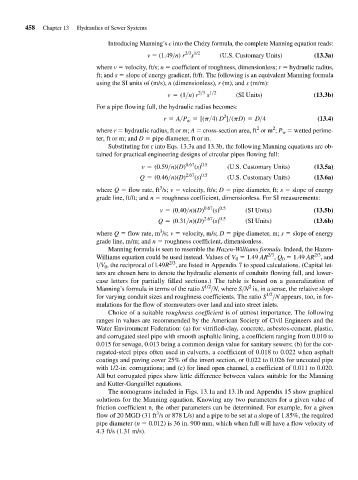Page 500 - Fair, Geyer, and Okun's Water and wastewater engineering : water supply and wastewater removal
P. 500
JWCL344_ch13_457-499.qxd 8/7/10 8:49 PM Page 458
458 Chapter 13 Hydraulics of Sewer Systems
Introducing Manning’s c into the Chézy formula, the complete Manning equation reads:
2/3 1/2
v (1.49>n) r s (U.S. Customary Units) (13.3a)
where v velocity, ft/s; n coefficient of roughness, dimensionless; r hydraulic radius,
ft; and s slope of energy gradient, ft/ft. The following is an equivalent Manning formula
using the SI units of (m/s), n (dimensionless), r (m), and s (m/m):
s
v = (1>n) r 2>3 1>2 (SI Units) (13.3b)
For a pipe flowing full, the hydraulic radius becomes:
2
r = A>P = [(p>4) D ]>(pD) = D>4 (13.4)
w
2
2
where r hydraulic radius, ft or m; A cross-section area, ft or m ; P wetted perime-
w
ter, ft or m; and D pipe diameter, ft or m.
Substituting for r into Eqs. 13.3a and 13.3b, the following Manning equations are ob-
tained for practical engineering designs of circular pipes flowing full:
v = (0.59>n)(D) 0.67 (s) 0.5 (U.S. Customary Units) (13.5a)
Q = (0.46>n)(D) 2.67 (s) 0.5 (U.S. Customary Units) (13.6a)
3
where Q flow rate, ft /s; v velocity, ft/s; D pipe diameter, ft; s slope of energy
grade line, ft/ft; and n roughness coefficient, dimensionless. For SI measurements:
v = (0.40>n)(D) 0.67 (s) 0.5 (SI Units) (13.5b)
Q = (0.31>n)(D) 2.67 (s) 0.5 (SI Units) (13.6b)
3
where Q flow rate, m /s; v velocity, m/s; D pipe diameter, m; s slope of energy
grade line, m/m; and n roughness coefficient, dimensionless.
Manning formula is seen to resemble the Hazen-Williams formula. Indeed, the Hazen-
2/3
2/3
Williams equation could be used instead. Values of V 1.49 AR , Q 1.49 AR , and
0
0
2/3
l>V , the reciprocal of l.49R , are listed in Appendix 7 to speed calculations. (Capital let-
0
ters are chosen here to denote the hydraulic elements of conduits flowing full, and lower-
case letters for partially filled sections.) The table is based on a generalization of
1/2
2
Manning’s formula in terms of the ratio S >N, where S>N is, in a sense, the relative slope
1/2
for varying conduit sizes and roughness coefficients. The ratio S >N appears, too, in for-
mulations for the flow of stormwaters over land and into street inlets.
Choice of a suitable roughness coefficient is of utmost importance. The following
ranges in values are recommended by the American Society of Civil Engineers and the
Water Environment Federation: (a) for vitrified-clay, concrete, asbestos-cement, plastic,
and corrugated steel pipe with smooth asphaltic lining, a coefficient ranging from 0.010 to
0.015 for sewage, 0.013 being a common design value for sanitary sewers; (b) for the cor-
rugated-steel pipes often used in culverts, a coefficient of 0.018 to 0.022 when asphalt
coatings and paving cover 25% of the invert section, or 0.022 to 0.026 for uncoated pipe
with 1/2-in. corrugations; and (c) for lined open channel, a coefficient of 0.011 to 0.020.
All but corrugated pipes show little difference between values suitable for the Manning
and Kutter-Ganguillet equations.
The nomograms included in Figs. 13.1a and 13.1b and Appendix 15 show graphical
solutions for the Manning equation. Knowing any two parameters for a given value of
friction coefficient n, the other parameters can be determined. For example, for a given
3
flow of 20 MGD (31 ft /s or 878 L/s) and a pipe to be set at a slope of 1.85%, the required
pipe diameter (n 0.012) is 36 in. 900 mm, which when full will have a flow velocity of
4.3 ft/s (1.31 m/s).

